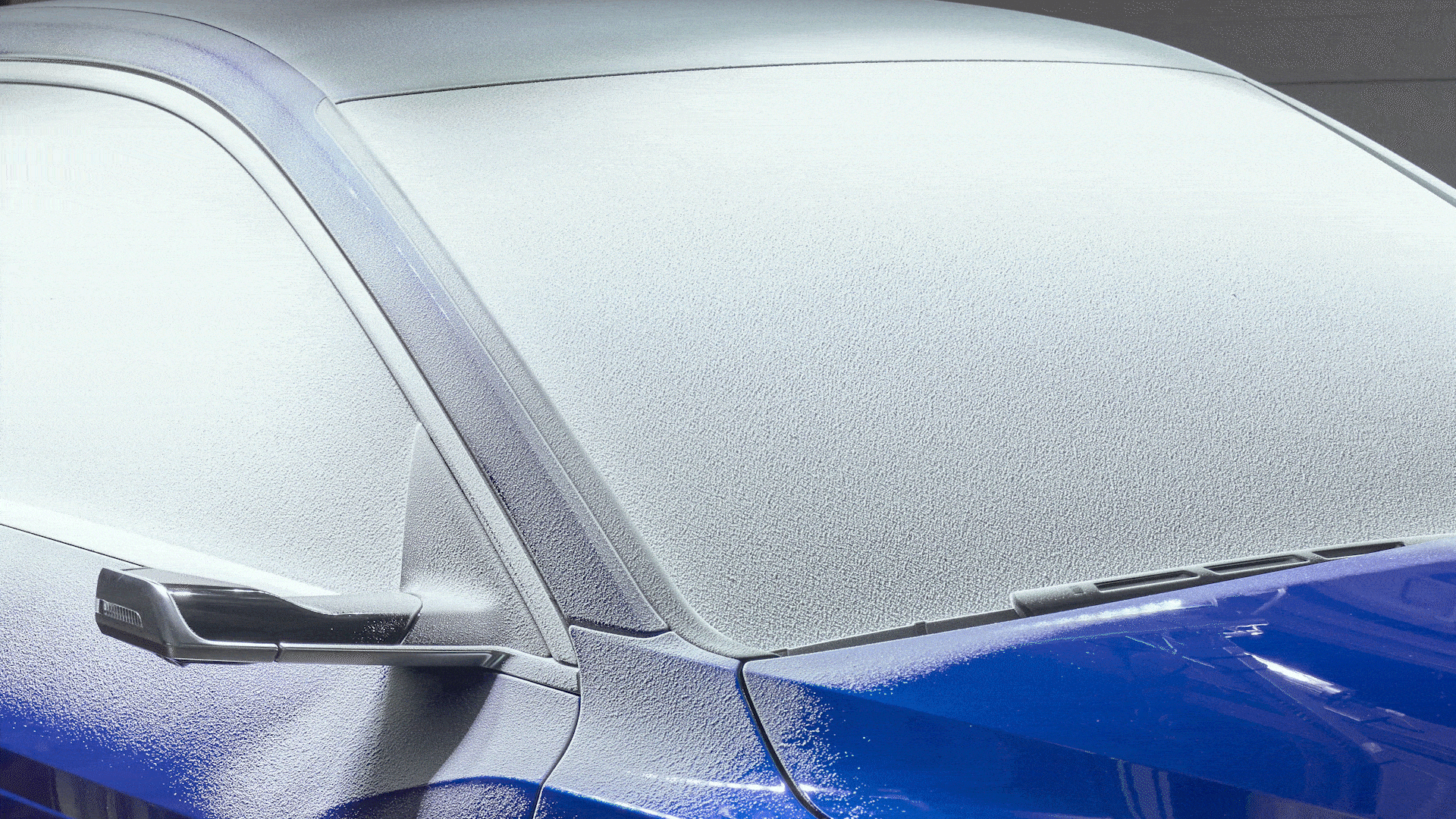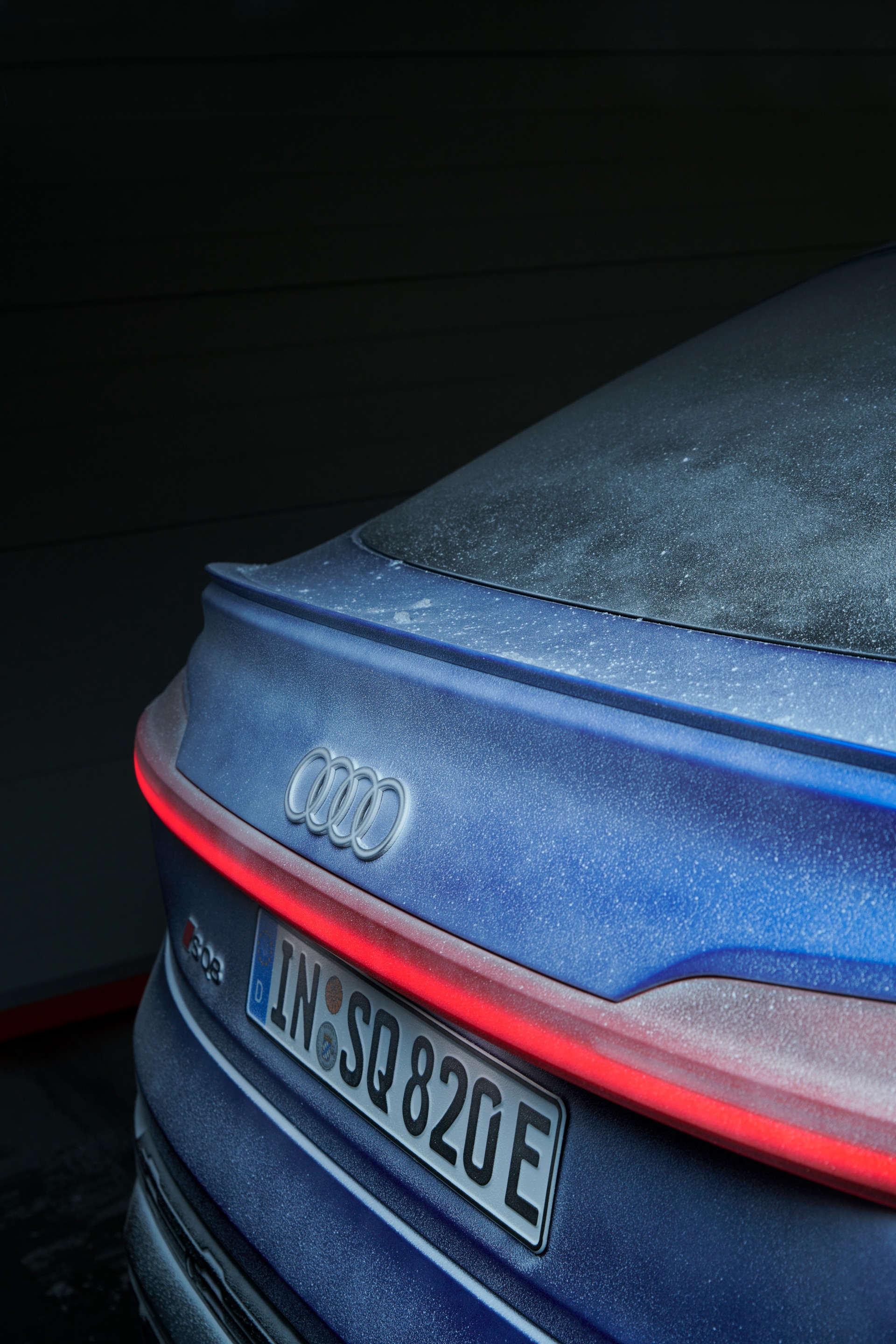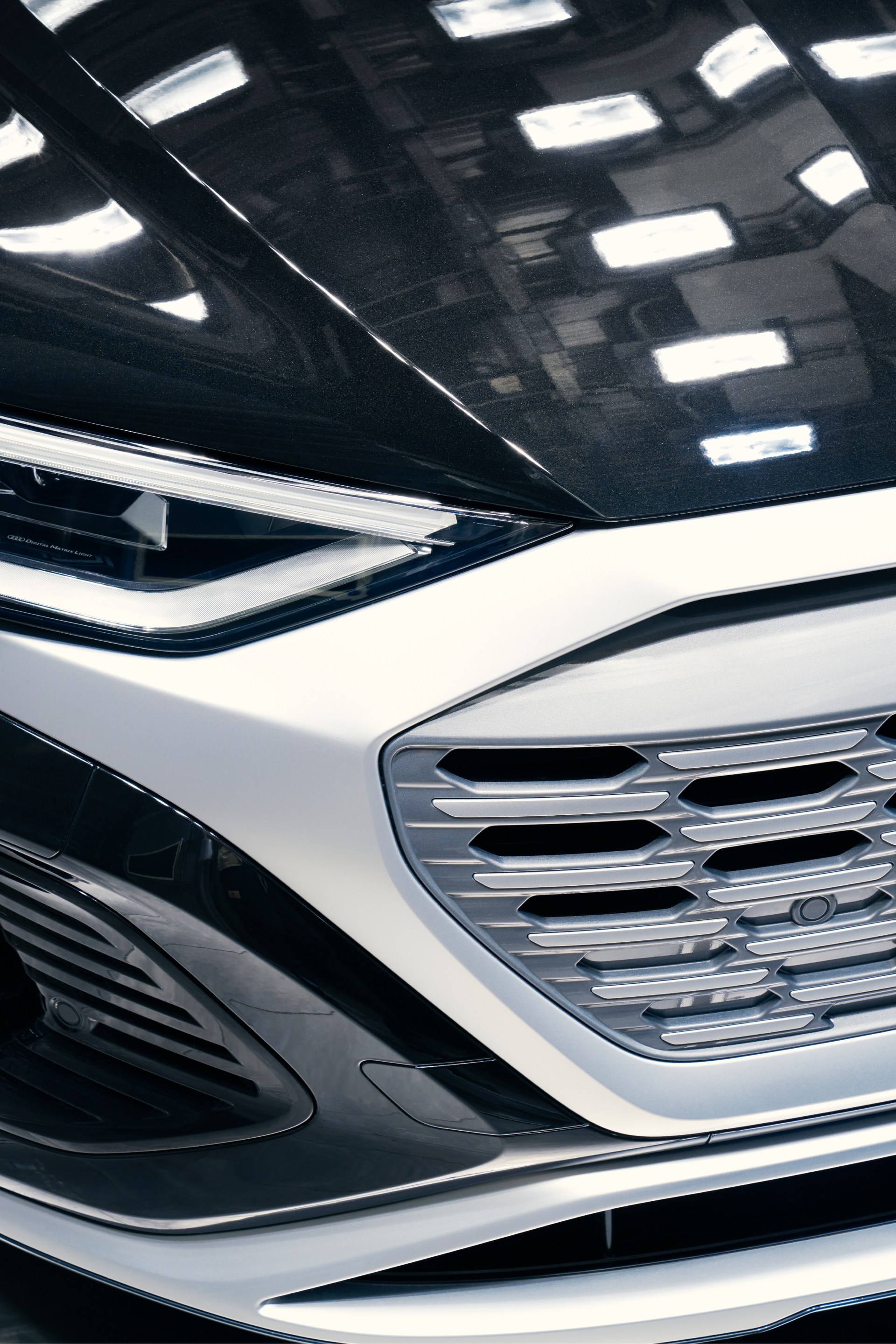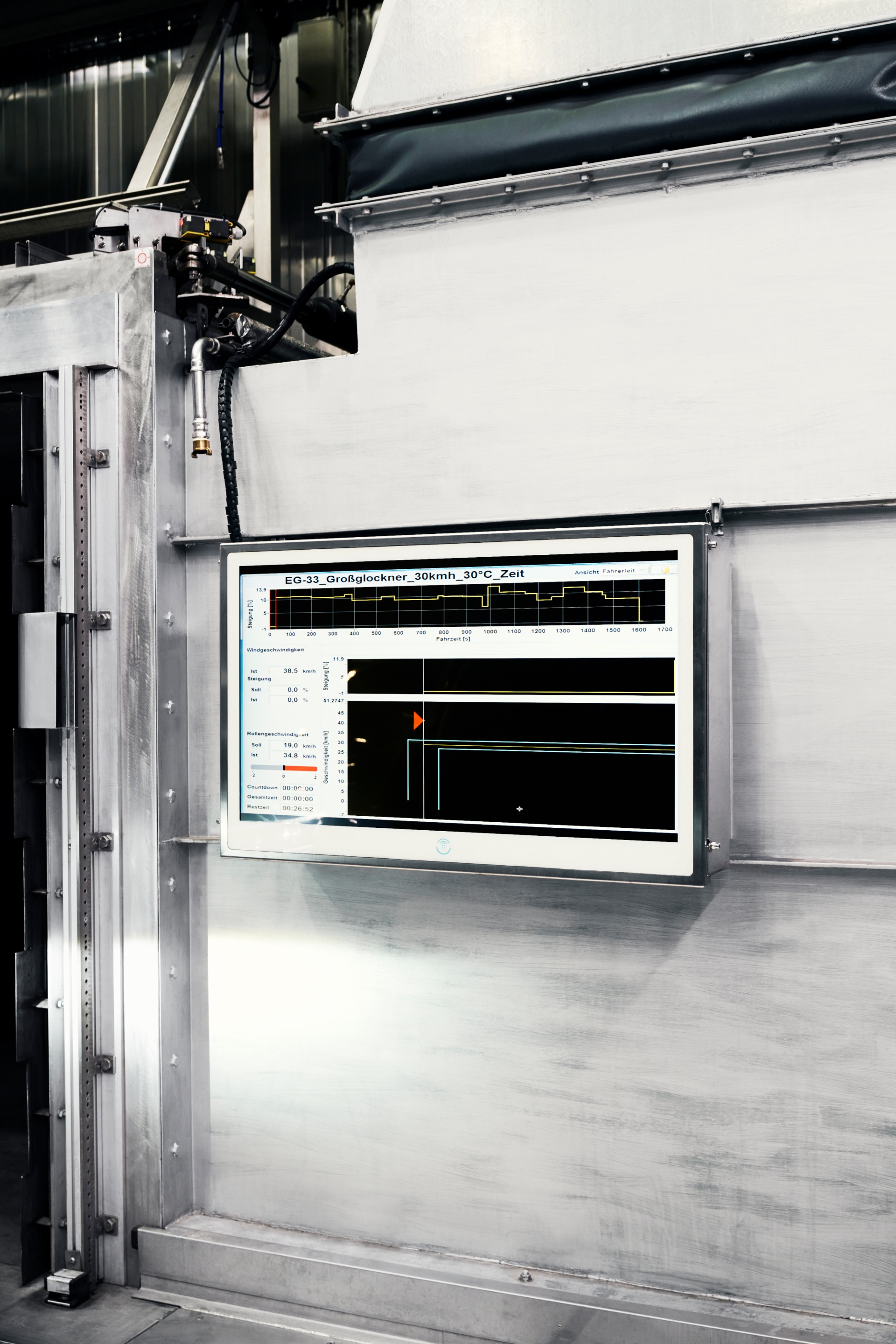“Tests under extreme conditions in the climatic wind tunnel”

Defrosting test using time-lapse images: in Audi’s climatic wind tunnel, tests are conducted in line with precisely defined parameters to establish how quickly the iced-up front windscreen of the Audi SQ8 Sportback e-tron clears.
Defrosting test using time-lapse images: in Audi’s climatic wind tunnel, tests are conducted in line with precisely defined parameters to establish how quickly the iced-up front windscreen of the Audi SQ8 Sportback e-tron clears.
Minus 18 degrees Celsius. A layer of ice obscures the front windscreen. The Audi SQ8 Sportback e-tron awaits its test in the conditioning box of Audi’s climatic wind tunnel. In order to ice up the electric vehicle, water has been sprayed onto the front windscreen in advance to create the legally required layer of ice. An employee sits in the Audi SQ8 Sportback e-tron and activates the “Defrost High” control, the air conditioning system’s maximum blower level on the front windscreen.
After three minutes, the first holes start to clear in the layer of ice on the front windscreen. Jürgen Ehemann, head of wind tunnels at Audi, who is monitoring the test on the bench, appears satisfied: “This is typical behaviour for an electric car. It provides heat from the first second the air conditioning is activated. On a petrol vehicle, the first holes start to clear after around five minutes, while diesel vehicles usually take seven minutes.”

The legally required layer of ice is applied in minus temperatures in the conditioning box of Audi’s climatic wind tunnel.

Every vehicle, irrespective of whether it has a combustion engine or electric motor, must clear a specific field of vision within a set period of time in the windscreen defrosting test as a requirement for approval.
The legally required layer of ice is applied in minus temperatures in the conditioning box of Audi’s climatic wind tunnel.
Every vehicle, irrespective of whether it has a combustion engine or electric motor, must clear a specific field of vision within a set period of time in the windscreen defrosting test as a requirement for approval.

The vehicles must withstand temperatures as low as minus 25 degrees Celsius in Audi’s climatic wind tunnel.

Electric vehicles undergo the same tests in Audi’s climatic wind tunnel as every other Audi.
The vehicles must withstand temperatures as low as minus 25 degrees Celsius in Audi’s climatic wind tunnel.
Electric vehicles undergo the same tests in Audi’s climatic wind tunnel as every other Audi.
We’re in Audi’s climatic wind tunnel at the heart of the Audi Technical Development division in Ingolstadt. The air humidity here can be regulated on various test benches, as can the wind and temperature – from minus 25 to plus 50 degrees Celsius.
The windscreen defrosting test is a requirement for approval in Europe and elsewhere. The Commission Implementing Regulation (EU) 2021/535 states that every vehicle type, whether combustion or electric, must have cleared a minimum field of vision on the front windscreen within a set period of time. Under reproducible conditions, the windscreen defrosting test simulates a vehicle parked outside in winter in sub-zero temperatures. All cars must meet the test’s windscreen defrosting requirements, including electric vehicles like the Audi SQ8 Sportback e-tron* and Audi Q8 Sportback e-tron* . As head of Audi’s Wind Tunnel Centre, Michael Zalud is the most senior figure on the test bench: “We make no distinction as to whether we are testing a vehicle with an electric motor or combustion engine. An Audi is an Audi.
“We make no distinction as to whether we are testing a vehicle with an electric motor or combustion engine. An Audi is an Audi.”
Michael Zalud

A quick-charging station with a charging capacity of 350 kW is also located in the conditioning box. This makes it possible to check the performance of the battery based on various driving profiles in sub-zero temperatures.
A quick-charging station with a charging capacity of 350 kW is also located in the conditioning box. This makes it possible to check the performance of the battery based on various driving profiles in sub-zero temperatures.
The advantages of an electric vehicle like the Audi Q8 Sportback e-tron under cold or warn conditions are impressive, according to Zalud: “On a combustion engine vehicle, the auxiliary heating is another combustion process that I am never able to start up in a garage or underground car park. And cooling down a combustion engine vehicle when parked is also not an option. All of these options are available on an electric car, however, because no harmful emissions are produced by activating the air conditioning. As such, it is not only possible to programme the auxiliary heating in the winter, but conversely also the cooling in summer: while I’m packing my things away by the lake at a temperature of 30 degrees, I can set a temperature of 20 degrees in the car via the myAudi app (depending on country-specific availability) and when I open it around ten minutes later in the car park, the Audi Q8 Sportback e-tron will have been cooled to a pleasant temperature and be ready to drive off.”
Sophisticated thermal management of the entire operating system is even more important for an electric vehicle than for a vehicle with a combustion engine. If too much energy is lost by heating the interior or if the units require too much energy for cooling, this energy is inevitably taken from the traction battery, which immediately reduces range. Intelligent thermal management, by contrast, that consumes minimal energy and uses as much air circulating around and flowing through the engine compartment as possible, permits a longer range.
So after the ice conditioning box, it’s time to move on to Audi’s next test – in the heat of the climatic wind tunnel. That’s where the Audi Q8 Sportback e-tron undergoes what is known as the Großglockner test. This involves simulating the route profile of the famous Alpine pass using the resistance of the rollers on the test benches.
Jürgen Ehemann: “The temperature of the battery must be optimally regulated on electric vehicles. We can simulate what would happen if the Audi Q8 Sportback e-tron were to drive along the Großglockner pass with or without a trailer. If the air conditioning of the interior is also turned up while under load on the mountain, a lot of power is also drawn from the battery. The software developed by Audi then decides whether heat dissipation from the battery is more important than maximum air conditioning. The Audi engineers can test all of these things here.”

The heat can be turned up to 50 degrees Celsius in Audi’s climatic wind tunnel.

Singleframe detail on the Audi Q8 Sportback e-tron.
The heat can be turned up to 50 degrees Celsius in Audi’s climatic wind tunnel.
Singleframe detail on the Audi Q8 Sportback e-tron.

The route profile of the Großglockner pass is simulated on the test bench.

The loads are set using resistance on the roller test bench.
The route profile of the Großglockner pass is simulated on the test bench.
The loads are set using resistance on the roller test bench.
In this case, this means that after a five-minute warm-up period, the Audi Q8 Sportback e-tron is put through its paces at 30 degrees Celsius: the resistance on the roller test bench simulates the real gradient of the Großglockner pass. In addition, the airstream can be simulated in the climatic wind tunnel, corresponding to the driving situation and the resulting cooling. The Audi Q8 Sportback e-tron must then maintain a speed of 30 km/h with a simulated trailer or 55 km/h without a simulated trailer.
“This test simulates extreme conditions – a relatively high load at low speed. We check whether the Audi Q8 Sportback e-tron maintains full functionality when subjected to such a load,” says Ehemann.
Yet the testing is far from over for the Audi Q8 Sportback e-tron. The electric vehicle still has to cope with a straight American pass at a temperature of 50 degrees Celsius – a different profile at higher speed than the meandering Großglockner pass.
“Under extreme conditions, we check whether the Audi Q8 Sportback e-tron can withstand all the demands placed on it.”
Jürgen Ehemann

A wide range of reproducible winter and summer conditions can be simulated in Audi’s climatic wind tunnel at any time, irrespective of the location, weather and season.
A wide range of reproducible winter and summer conditions can be simulated in Audi’s climatic wind tunnel at any time, irrespective of the location, weather and season.
The Audi Wind Tunnel Centre
A wide range of reproducible winter and summer conditions can be simulated in Audi’s climatic wind tunnel at any time, irrespective of the location, weather and season. Audi engineers working on the interior air conditioning, drive system development and overall vehicle development use it to conduct various tests. To this end, different speed and temperature curves as well as load scenarios are simulated on different test benches using various resistance settings, in line with the specifications defined by the relevant Audi departments.
Homologation tests that are required for approval purposes are generally conducted in the presence of independent technical services, who monitor the processes at Audi’s Wind Tunnel Centre. To this end, the test laboratory at the Wind Tunnel Centre works in accordance with the requirements of DIN EN ISO/IEC 17025.
And for another extreme test, Audi’s climatic wind tunnel is heated to 35 degrees Celsius while the vehicle travels 60 kilometres at top speed. This doesn’t reflect the everyday use of an electric vehicle, of course, but the Audi Q8 Sportback e-tron* is being tested to see how it can cope with maximum loads – just like any other Audi. And not just on a test drive anywhere in the world, but on test benches in Audi’s climatic wind tunnel.



